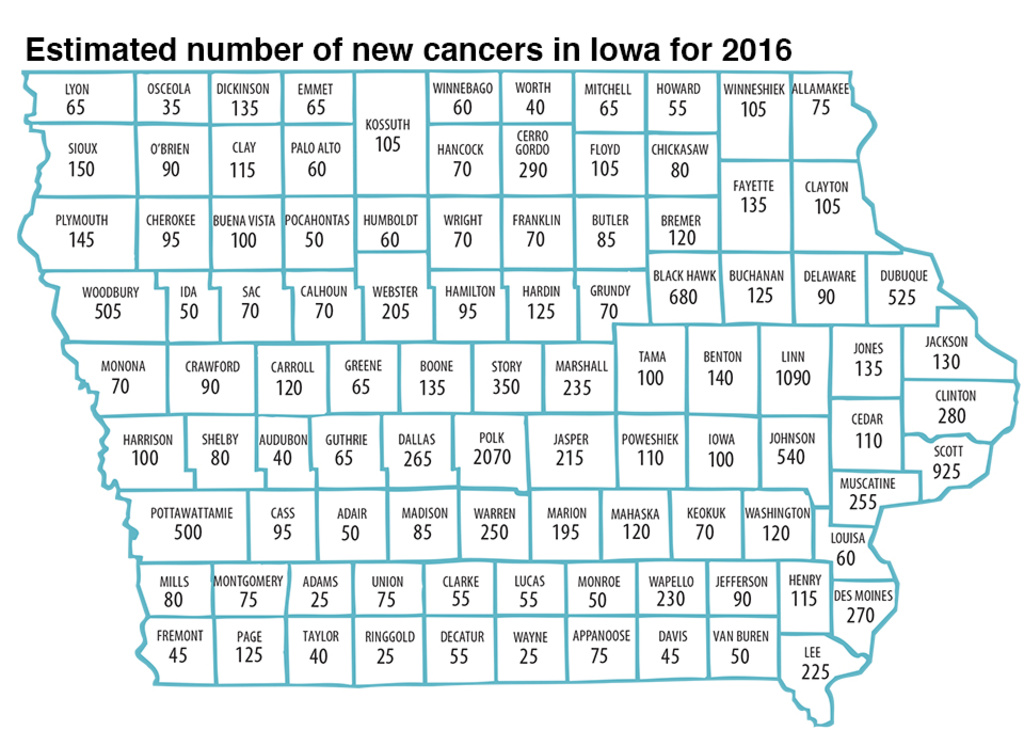2016 Cancer in Iowa, the annual report released March 30 by the State Health Registry of Iowa, based in the University of Iowa College of Public Health, estimates 16,600 new cancers will be diagnosed among Iowa residents in 2016. In addition, an estimated 6,400 Iowans will die from cancer, according to the report.
“Lung cancer continues to be the most common cause of cancer death for both males and females,” says Mary Charlton, Ph.D., assistant professor of epidemiology at the UI College of Public Health. “It will be responsible for one out of every four cancer deaths in Iowa.”
According to Charlton, breast cancer will remain the most common type of cancer diagnosed among females, and prostate cancer remains the most common type among males. However, prostate cancer rates have been declining, likely due to recommendations against prostate-specific antigen (PSA) screening by the U.S. Preventive Services Task Force.
The report, based on data from the Iowa Cancer Registry and the Iowa Department of Public Health, is available online in the "publications" section on the registry’s website or by calling the registry at 319-335-8609. The report includes county-by-county statistics, summaries of new research projects, and a section focused on cancer among adolescents and young adults.


Cancer is the leading cause of disease-related death in the adolescent and young adult (AYA) population in the United States (defined as people between the ages of 15 and 39). Only accidents, suicide, and homicide claim more lives than cancer in this age group.
Charlton notes that three types of cancer have been substantially increasing among adolescents and young adults: skin melanoma, thyroid, and testicular cancer.
“Skin melanoma rates in people under 40 have doubled since 1974,” she says. “Given that the rates in females are increasing so much more than rates in males, it seems likely that the tanning behaviors, including outdoor sun exposure and use of indoor tanning booths, in this age group are primarily responsible for this trend.”
Thyroid cancer has been increasing in the adolescents and young adults by 5 percent per year over the past 10 years in both Iowa and the U.S., while testicular cancer has also been increasing, especially among white males who have five times greater risk of developing testicular cancer compared to black males.
Fortunately, survival rates for all types of cancer are relatively high in adolescents and young adults (87 percent among Iowans), which is higher than the U.S. average, and survival rates continue to trend upward.
According to William Terry, clinical assistant professor of pediatrics, hematology/oncology at the UI Carver College of Medicine, there is still room for improvement in this area, beginning with prevention and screening efforts in order to detect these cancers earlier or prevent them from occurring in the adolescent and young adult population.
“This includes limiting UV exposure, checking skin for changes that might indicate melanoma, self-exams for testicular changes in young men, and receipt of the HPV vaccine for both young men and young women,” Terry says.
Because of the wide variety of needs and challenges specific to adolescents and young adults, Holden Comprehensive Cancer Center and University of Iowa Children’s Hospital have joined forces to create the AYA Cancer Program. This program will provide comprehensive care to this special population and focus on their special needs, such as working with adolescent and young-adult cancer patients regarding fertility preservation, focusing on their social needs, and transitioning to long-term survivorship to ensure a healthy future after cancer.
George Weiner, director of Holden Comprehensive Cancer Center at the UI, says that, historically, cancer patients under 18 have been cared for by pediatric oncologists and those over 18 have been cared for by adult oncologists.
“We now know that the cancers that occur in these patients are different from those in younger children or older adults. They respond differently to cancer therapy,” Weiner says. “The psychosocial needs of AYA patients and their families are also unique. We are excited about how our more integrated approach to research and cancer care for adolescent and young adult cancer patients is helping us both accelerate progress and provide outstanding, coordinated care.”
The State Health Registry of Iowa has been gathering cancer incidence and follow-up data for the state since 1973.
